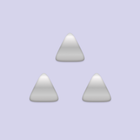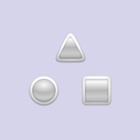Silver nanoplates are surface plasmon resonant (SPR) platelet-shaped nanoparticles that have extremely large absorbing and scattering cross-sections across the visible and near-IR regions of the spectrum. By precisely controlling the plate diameter and thickness, the nanoplate’s optical resonance can be tuned to peak at specific wavelengths (500–1300 nm). Nanoplates have applications in surface-enhanced Raman scattering (SERS), photovoltaics, molecular detection, and photothermal cancer therapies. Nanoplates are available with spectral properties optimized for green, yellow, red, and near-IR excitation.
- Ag Mass concentration: 0.02 mg/mL or 1 mg/mL.
- Ag atomic molarity: 0.185 mmol/L or 9.25 mmol/L.
Plates are available with a polyvinylpyrrolidone (PVP) surface as well as with silica shells.

By modifying the synthesis conditions, nanoplates with peak resonance from 500–1300 nm can be produced. To receive nanoplates with a custom resonance wavelength peak please contact us.
Surface Functionalization
Silver nanoplates are available with a variety of capping ligands and coatings. To increase stability and to maintain consistency with other nanoComposix silver nanoparticles for comparative purposes, our standard silver nanoplates are available with either a polyvinylpyrrolidone (PVP, MW = 40 k) capping agent (suspended in a 5mM sodium borate buffer) or coated with a ~15 nm silica shell (suspended in a 10 mM sodium bicarbonate buffer). Plates are also available with polyvinyl alcohol (PVA) or sodium citrate capping agents, or other capping agents as a custom order.
Applications
The unique optical properties of the nanoplates make them an interesting candidate for applications including surface-enhanced Raman scattering (SERS), photovoltaics, molecular detection, and photothermal cancer therapies.
Silver nanoplates also have an unusual optical property in that if they are transferred to a water or salt solution, the silver nanoplates will selectively dissolve at their edges. This results in a gradual shift in color over time. Applications of the color shift include their use as indicators for expiry or exchange. For use of the nanoplates in custom color changing applications, please contact us.
Frequently Asked Questions
-
Do silver nanoparticles oxidize?
Yes, silver will oxidize in the presence of sulfur and oxygen. Please see our Nanotoxicology Knowledge Base article for additional details. -
How do I tell if the silver nanoparticles that I’ve purchased have gone bad?
Monitoring the UV-Visible signature of silver nanoparticles over time is a good method of ensuring that the particles are still "good". If there is a destabilization event, the color will usually change dramatically and it is clear that the particles have aggregated. -
Why do you use PVP as a capping agent?
Silver nanoplates are available with a variety of capping ligands and coatings. To increase stability and to maintain consistency with other nanoComposix silver nanoparticles for comparative purposes, our standard silver nanoplates are available with either a polyvinylpyrrolidone (PVP, MW = 40 k) capping agent (suspended in a 5mM sodium borate buffer) or coated with a ~15 nm silica shell (suspended in a 10 mM sodium bicarbonate buffer). Plates are also available with polyvinyl alcohol (PVA) or sodium citrate capping agents, or other capping agents as a custom order. -
Can I order silver nanoplates with a different capping agent for SERS (Surface Enhanced Raman Spectroscopy) or other applications?
Our standard silver nanoplate products are capped with PVP; while the polymer coating provides very good stability, the surface of the nanoplates is less accessible for direct binding of analytes or other species. For customers who are interested in SERS applications or other work where molecular binding to the surface is of interest, we recommend also testing nanoplates capped with citrate. While these materials are less stable over time with respect to etching, the more accessible surface may provide larger Raman enhancement. Contact us for more information on the citrate-capped silver nanoplates, or on other custom surface functionality for your application. -
Why are the plates delivered in a borate buffer instead of pure water?
Due to the nanoplates’ inherent sensitivity to their environment, we prefer to provide the nanoplates in a borate buffer to prevent etching during shipping and long-term storage. If this is not suitable for your application, please contact us to discuss other solvent possibilities, including the fabrication of nanoplates that are soluble in organic solvents. -
How do I store and handle my silver nanoplates?
Plates are particularly sensitive to environmental conditions (as compared to spherical silver) because the high surface energy associated with sharp edges and corners at the atomic scale causes the silver ions to be considerably more labile and prone to etching by species in the surrounding media or atomic rearrangement. Generally speaking, exposure to light, oxygen, chloride or other halogen ions, solution pH, and temperatures all influence the rate at which the nanoplates ripen or etch, and the rate at which silver ions are released into solution. This change in nanoplate morphology and size can be detected visually and spectroscopiocally, manifested as a blue-shift in the nanoplate plasmon resonance. To curb this shift, we have performed extensive stability studies on our silver nanoplates in various buffers and capping agents to maximize their stability. We now offer our silver nanoplates in a 5 mM sodium borate buffer instead of Milli-Q water, which nearly eliminates this blue-shift. When not in use, we recommend that the nanoplates should be stored away from light at 4°C. -
Why is my nanoplate peak wavelength resonance different than the value on your specification sheet?
At the nanoscale, the size and shape of particles can change over time. Typically this is due to reorganization of the atoms within the particle. Since the plasmon resonance is so sensitive to aspect ratio, even low rates of dissolution can cause a noticeable shift in the peak resonant wavelength. -
I’d like a nanoplate with a different resonance or a different surface. Are these available?
We can make nanoplates with resonant wavelengths from 500–1300 nm and with polyvinyl alcohol (PVA) or sodium citrate capping agents. Silver nanoplates with other optical properties, sizes, or different surface capping agents are available as a custom order. Contact us for more information about our custom fabrication abilities.

